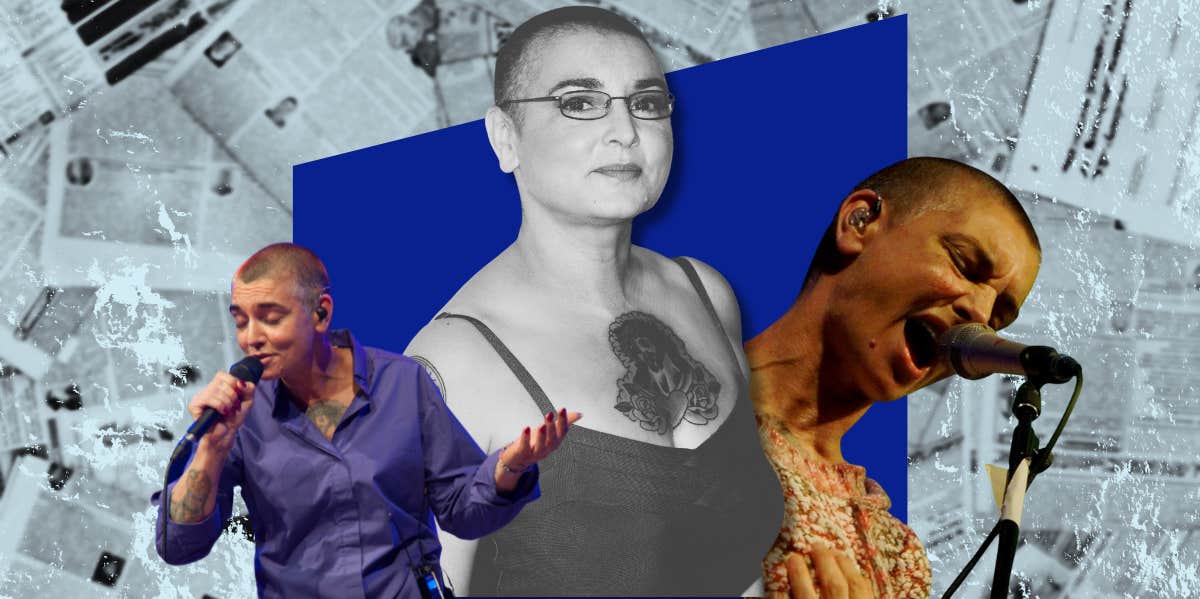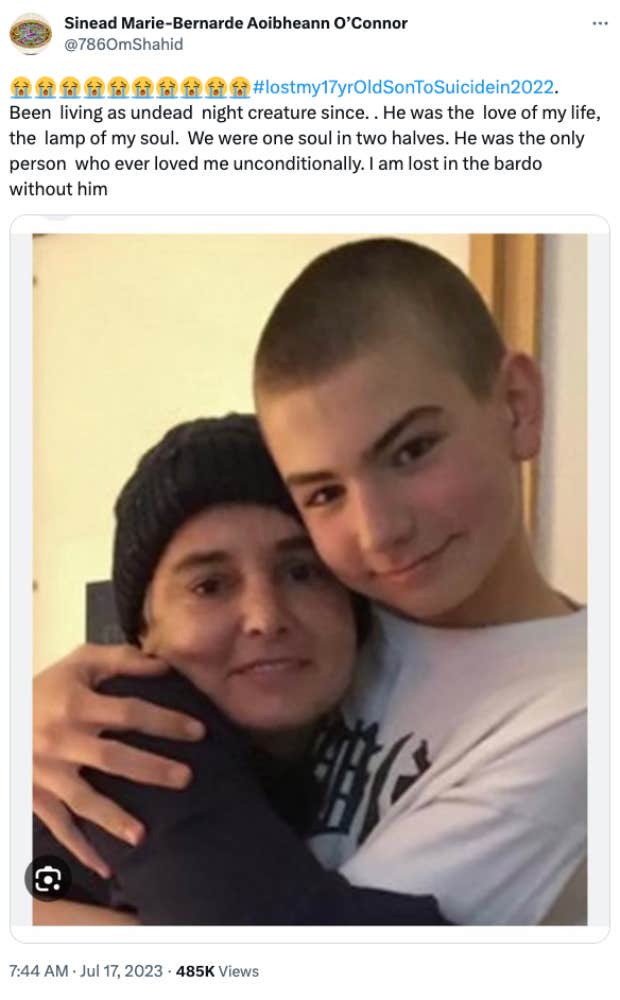Sinead O'Connor's Perseverance Was An Act Of Heroism — And It Should Be Her Legacy
O'Connor spoke her mind and never backed down, despite enduring the kind of tragedy that destroys all but the lucky few.
 s_bukley via Shutterstock / Bryan Ledgard and Man Alive! via Wikimedia Commons / Fedor Kozyr via Canva
s_bukley via Shutterstock / Bryan Ledgard and Man Alive! via Wikimedia Commons / Fedor Kozyr via Canva Sinéad O'Connor was one of those rare cultural forces who seemed to come out of nowhere, as if materializing from thin air — one minute you'd never heard of her and then, suddenly, she was absolutely everywhere.
I viscerally remember being a tween home on summer vacation in 1990, plopped all day long in front of MTV like every other Gen X'er and Millennial and Xennial, and that signature bald head suddenly popping up on the screen along with the opening chord of "Nothing Compares 2 U," the song that made her an instantaneous, if brief, household name.
Of course, the shaved head, a shocking break with convention for a woman at the time, helped immediately cement her in everyone's minds. But the world is littered with one-hit wonders who ride in on the back of some gimmick and quickly fade from memory—or if they do stick in people's heads, it's for their kitsch value.
With O'Connor, it was the voice that made her stick in the collective craw and remain there for more than 30 years — the power, the almost liquid emotion, and especially the visceral heartbreak with which she sang. Which, in a way is fitting, even if perversely so — it was heartbreak that seemed to form O'Connor's very core, and she wielded it like a weapon in an effort to change hearts and minds, even as her own were breaking beneath the weight of all that happened to her.
With Sinéad O'Connor's death at age 56, she leaves behind a legacy as complicated as her life.
O'Connor's death comes just two years after the release of her memoir in which she detailed her often heartbreaking life. In her book, 'Rememberings,' O'Connor detailed how her overnight fame nearly broke her, even as it made her an icon to an entire generation.
After barnstorming into worldwide pop culture in 1990, O'Connor quickly went to work using her overnight fame for activism, most famously — and infamously — by criticizing the Catholic Church in a 1992 appearance on "Saturday Night Live." At the end of an a capella version of Bob Marley's "War," she tore up a picture of Pope John Paul II to protest the Church's long and horrifying history of child sexual abuse — a cause O'Connor said was close to her heart because she experienced it herself during her horrific childhood in Ireland.
A public flogging quickly ensued, with Joe Pesci using his "SNL" monologue the following week to say he'd like to beat O'Connor up for her slight against the Church. Even Madonna, who'd made an entire career out of parodying the Catholic Church, joining the criticism.
It never seemed to occur to anyone at the time that O'Connor, who refused to apologize for the stunt, was actually right.
Years later, O'Connor would reveal her heart-wrenching struggles with mental illness.
These struggles were only exacerbated by her overnight fame and the controversy that ensued. At times, O'Connor revealed these struggles by acting out on social media, particularly during mental health emergencies in 2015 and 2017, the latter of which she said in an interview with TV's Dr. Phil included eight separate suicide attempts in one year.
In the increasingly vicious, dehumanizing, empathy-averse culture to which social media has given rise, those incidents saw her once again become a target for criticism and ridicule as social media users gleefully made her the butt of the usual jokes that often accompany manifestations of mental illness.
It was perhaps those experiences that made O’Connor sometimes seem haunted by her conditions and worried that her public struggles with bipolar disorder, borderline personality disorder and Complex PTSD would eclipse her legacy as a musician, mother and activist and mother who never shied away from fighting for what she believed in, even in the face of constant public vitriol and mockery.
We have a duty to remember O'Connor not for the illnesses she candidly struggled with, but for the art she made and the fights she took on in spite of them.
It’s unknown as of this writing how O’Connor passed away, but those of us who struggle with trauma and mental illness like she did can sense they had a hand in taking her from us — whether by her own hand or because of a broken heart.
Part of the battle of mental illness is the worrying possibility you will one day pass away because of it, by one means or another. O’Connor's struggles are ones that, to an extent, I know personally. Though not to the level of hers, I too had a heartbreaking childhood and have been diagnosed with bipolar disorder and Complex PTSD, a form of the condition arising from multiple and sustained traumatic events over an extended period of time, and which is often more debilitating than the usual form.
That has certainly been my experience, and it sounds like it was O’Connor’s as well. "You can never predict what might trigger the [PTSD],” she told People in 2021 around the release or her book. “I describe myself as a rescue dog: I'm fine until you put me in a situation that even slightly smells like any of the trauma I went through."
Just six months after that interview, O’Connor was dealt another tragic and traumatic loss — her son Shane’s suicide in January of 2022, an event that was at the center of O’Connor’s final public statements on Twitter just over a week ago. In a tweet on July 17, 2023, she called Shane “the lamp of my soul” and expressed that she had “been living as [an] undead night creature” since his death.
 Photo: @786OmShahid / Twitter
Photo: @786OmShahid / Twitter
But even without fresh daggers to the heart, the thing people rarely seem willing to understand about the suicidality that often comes with severe mental illness is that it never quite leaves you, no matter how healthy or "recovered" you become.
That familiarity and intimacy with the idea of oblivion is a rubicon that, once crossed, you can never really reverse, and it changes your attitude toward both life and death. It’s a loss of innocence, in a way — we tend to think of the boundary between life and death as a brick wall several feet thick, but in reality, the membrane between living and dying is terrifyingly thin, pierceable with just a pin-prick by our own hands. That knowledge is a heartbreak all its own, heaped on top of the horrors you've already endured in the first place.
People like to think of suicidality as a simple case of mind over matter, but that’s the polar opposite of how it actually works. To carry mental illness inside you is, to one degree or another, carry around a ticking time bomb. It may never actually go off — and for many, it never does. But that’s the thing about ticking time bombs, isn’t it—you never truly know what they’re going to do.
O'Connor found a way to not only survive the horrors inflicted upon her but go beyond them in ways that changed the world.
It's proof that people with disabilities like mental illness are more than the broken brains they received through no fault of their own. In O’Connor’s case, she was also a genius whose art went far beyond the MTV mega-hit that rocketed her to fame, a career that spanned four decades.
She was also a boundary-breaking activist throughout her adult life, speaking out about issues as diverse as Ireland's political struggles to AIDS epidemic at a time when its victims were pariahs at best.
And while protesting the Catholic Church’s sexual abuse is hardly controversial nowadays, in 1992 absolutely nobody was ready to hear it. That did nothing to dampen O'Connor's impact, however — filmmaker Kathryn Ferguson has credited O’Connor’s willingness to criticize the Church with laying the groundwork for turning points like the Republic of Ireland’s legalization of same-sex marriage in 2015 and Northern Ireland’s legalization of abortion in 2019.
She may not have been a perfect advocate or artist or figure — no such figures exist in the first place — but she certainly was a fearless one, right to the end. If it turns out her life ended by her own hand, it is not a "waste" or a "tragedy" or any of the other platitudes and judgments we like to dole out about people who die of mental illness.
Staying alive and continuing to fight, for any duration, when you've been through what O'Connor survived is heroic in and of itself. I’m thankful that, even if we didn’t have her for as long as we could have, we had her as long as we did — that she endured as long as she could. That’s a gift she did not owe us, but one she gave anyway. You can’t really ask more of anyone than that.
John Sundholm is a news and entertainment writer who covers pop culture, social justice and human interest topics.
